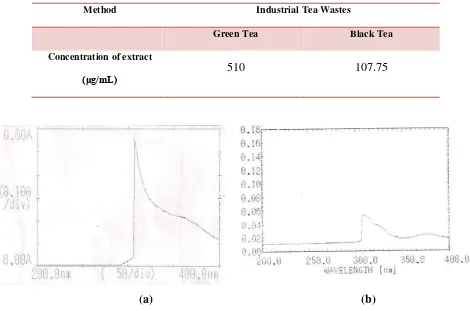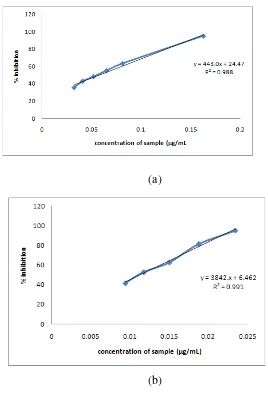1
POTENCY OF INDUSTRIAL TEA WASTE:
COMPARISON BETWEEN GREEN AND BLACK TEA INDUSTRIAL
WASTES AS UV FILTER FOR SUNSCREEN
Yohanes Martono
Chemistry Department Faculty of Science and Math Satya Wacana Christian University
Jl. Diponegoro 52-60 Salatiga
*Corresponding author: Yohanes Martono, Chemistry Department, Faculty of Science and Math, Satya Wacana Christian University, Salatiga, Indonesia, [email protected].
Abstract
2 antioxidant activity but adversely, black tea had higher total phenolic contents. UV filter effectiveness is affected by polyphenols content in substances, so it suggested that black tea waste extract is more potential than green tea waste extract as photoprotection substance.
Keywords: tea waste, UV filter, sunscreen
Background
Solar UV light reaching earth is a combination of both UVB (290–320 nm) and UVA (320–400 nm) wavelengths. In the past two decades, a dramatic increase has been noted in the incidence of non melanoma skin cancer (NMSC). The major environmental influence on the development of NMSC is exposure to ultraviolet (UV) radiation, which generates reactive oxygen species and free radicals that damage a variety of cellular molecules. In animal models of chemical and ultraviolet-induced carcinogenesis, green and black teas demonstrate anti-tumor activity even when administered after UVB exposure (Rees et all., 2007).
3 Indonesia is one of ten biggest countries that export tea. It means that Indonesia has many tea industries (Anonym, 2008). Every tea industry produces tea product and tea waste. There are abundant industrial tea wastes, both of green and black tea. Our previous study showed that both of green and black tea wastes extract still have antioxidant activity and phenolic compounds. Because of phenolic compounds capable to scavenge free radicals from UV exposure, we interest to investigate antioxidant activity, total phenolics and UV filter effectiveness of both green and black industrial teas waste.
Methods
Chemicals. Samples, both of green and black tea wastes was obtained from beverages company in Bawen, Semarang, Central Java. DPPH and Folin-Chiocalteou phenol reagent, tri-chloro acetic (TCA), FeCl3, and K4Fe(CN)6 were
obtained from Merck. All solvent such as methanol and ethyl acetic were also purchased from Merck, Germany.
Tea Waste Extract Preparation
4
Determination of Total Phenolic Content (Singleton et all., 1999)
The total phenolic contents of extracts was determined using to the Folin-Ciocalteu method. 1 mL extracts were added with 2 mL Folin-Folin-Ciocalteu reagent, and the reaction was neutralized with 2.5 mL sodium carbonate 7.5%. The absorbance of the resulting blue color was measured at 765 nm after 30 min. Using galic acid as standard total phenolic content was expresed as mg GA equivalent/gram of sample. Data reported of three replications.
Assay of Reducing Power (Koleva et all., 2007)
1 ml of extract solution was mixed with 2.5 ml phosphate buffer( 0.2 M, pH 6.6) and 2.5 ml potassium ferricyanide [ K3Fe(CN)6] 1%, then mixture was incubated
at 50 degree C for 20 minutes. Two and one-half, 2.5 ml of trichloroacetic acid (100g/l) was added to the mixture, which was then centrifuged at 3000 rpm for 10 min. Finally, 2.5 ml of the supernatant solution was mixed with 2.5 ml of distilled water and 0.5 ml FeCl3 0.1% and absorbance measured at 700nm in UV-Visible
Spectriphotometer (Shimadzu, UVMini 1240). Potassium ferrocyanide was used as standard. Increased absorbance of the reaction mixture indicates stronger reducing power.
DPPH Radical Scavenging Activity (Lim et all, 2006)
5 dissolution was added with 2 mL DPPH 0.02 mM. Control solution was made from 1 mL of methanol 80% and was added by 2 mL DPPH 0.02 mM. As blank was 3 mL methanol 80%. Sample solution was then incubated for 30 min and absorbance of each solution was measured at 517 nm. Scavenging of the DPPH free radical was measured using the following equation:
Inhibition concentration of 50 % DPPH radical-scavenging sample was measured by linear regression method.
UV Filter Effectiveness Assay (Walter, 1997)
Optimum wavelength was determined by scanning sample solution in range 200 – 400 nm. Sample, both green and black tea waste extract was then dissolved with methanol 80% in various concentration, 60 µg/mL – 520 µ g/mL. Sample solutions were then measured at optimum wavelength. UV filter effectiveness was determined by sample absorbance conversion following equation :
UV filter effectiveness = - log A
6
Discussion
Determination of total phenolic content
Folin–Ciocalteu is a method used for the determination of total phenolic compounds. The content of phenolic compounds is expressed as mg gallic acid equivalent (GAE) per gram sample. The amounts of total phenolics contents in industrial teas waste are shown in Table 1. A higher content was observed in black tea waste in comparison with greean tea waste. Tea is known to have a high content of polyphenolics, about 36% polyphenols on a dry weight basis (Shahidi, 2000). As reported previously, theaflavin (TF) are low (2–6% of extracted solids) and thearubigens (>20%) are high in black tea, whereas in green tea, catechins are much higher (30–42%), particularly EGCG, which is the most abundant catechin (Lee and Lee, 2002).
Evaluation of the antioxidant activity
Reducing Power Assay
7 the formation of Perl’s Prussian blue at 700 nm (Ara and Nur, 2009) and was measured as mol equivalent K4Fe(CN)6/gram sample.
The result showed that green tea waste extract had higher antioxidant activity in comparison with black tea. This result was consistent with Lee and Lee (2002) that antioxidant activity of green tea extract was higher than black tea.
DPPH Assay
The concentration of an antioxidant needed to decrease the initial DPPH concentration by 50% (IC50) is a parameter widely used to measure antioxidant
activity. The lower the IC50 is the higher the antioxidant activity. The scavenging
activity of both green and black teas waste extracts is shown in Table 2. Linear regression of both green and black industrial tea wastes to calculate IC50 were
shown in Figure 1.
8 UV Filter effectiveness
UV Filter effectiveness of both green and black teas waste extract is shown in Table 3. Spectra scanned of both green and black tea waste extract showed that green tea waste extract had optimal absorption at 307 nm, but black tea waste extract had optimum absorption at 307 and 337 nm. This study showed that black tea waste had wider UV protection range than green tea. Black tea can absorb UVB and UVA light although in different intensity, while green tea waste only absorbs UVB light. This fact explained that polyphenols may also contribute to endogenous photoprotection. Spectra of each extract were shown in Figure 2.
9
Conclusion
Based on our study, we concluded that although green tea waste extract had higher antioxidant activity but adversely, black tea had higher total phenolic contents. UV filter effectiveness is affected by polyphenols content in substances, so it suggested that black tea waste extract is more potential than green tea waste extract as photoprotection substance.
Acknowledgment
We would like to thank Coca-cola Botling, Indonesia for their contributions give industrial both green and black teas waste that made this work possible.
Tables and figure
Table 1. Total Phenolic Contents (mg GAE/gram sampel) of Both Industrial Tea Wastes
Green and Black Tea
Method Industrial Tea Wastes
Green Tea Black Tea
10
Table 2. Antioxidant Activity of Both Green and Black Tea waste Extract (mek/gram
sampel)
Method Industrial Tea Wastes
Green Tea Black Tea
Reducing Power
(mek/gram)
4.28 ± 0.21 2.38 ± 0.01
IC50 DPPH (μg/mL) 57.5 88.6
Table 3. UV Filter Effectiveness Concentration To Yield Maximum Protection
Method Industrial Tea Wastes
Green Tea Black Tea
Concentration of extract
(μg/mL) 510 107.75
[image:10.595.110.518.172.295.2]
(a) (b)
[image:10.595.76.546.381.692.2]11 (a)
[image:11.595.157.425.87.480.2](b)
Figure 1. Linear regression profile of concentration sampel vs % inhibition DPPH; (a) green tea waste extract; (b) black tea waste extract
(a) (b)
[image:11.595.74.480.565.695.2]12
References
Anonym, 2008, Sixty-Fourth Report On Export Of Tea, http://rajyasabha.nic.in.
Koleva, I.I., T.A. Van Beek, J.P. H.Linssen, A. De Groot and L.N. Evstatieva, 2002, Screening of plant extracts for antioxidant activity: a comparative study on three testing methods, Phytochemical Analysis,13, 8-17.
Lee, K.W., and Lee, H.Y., 2002, Antioxidant Activity of Black Tea vs. Green Tea, American Society for Nutritional Sciences. J. Nutr., 132, 785.
Lim Y. Y., T. T. Lim, and Tee, J.J., 2006, Antioxidant Properties of Guava Fruit : Comparison With Some Local Fruits. Sunway Academic Journal 3, 9 – 20.
Mamati, E.G., Liang Y., Lu J, 2004, The role of tea polyphenols in protection of plants against UV-B. Proc. 2004 International Conference on O-Cha (tea) Culture and Science (ICOS), Nov. 4-6, 2004. Shizuoka, Japan. 280-289.
Rees, J.R., Stuckel, T.A., Perry, A.E., Zens, M.S., Spencer, S.K., and Karagas, M.R., 2007, Tea consumption and basal cell and squamous cell skin cancer: results of a case control study, J Am Acad Dermatol, 56, 5, 781–785.
Shahidi, F, 2000, Antioxidants in food and food antioxidants. Nahrung, 44, 158– 163.
13 Singelton, V., R., Orthifer, R., Lamuela-Raventos, R., M., 1999. '' Analysis of total phenols and other oxidation substrates and antioxidants by means of Folin-Ciocalteu reagent'' Methods in Enzymology. 299, 152-178.
Walters, C., Keeney, A., Wigal, C.T., Johnston dan Cornelius, R., 1997, The Spectrophotometric Analysis and Modelling of Sunscreens, J. Chem. Educ, 74, 1, 99-10.


